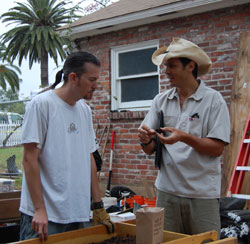SDSU Archaeology Team Unearthing Long-Buried Whaley House Artifacts
SDSU anthropology professor Seth Mallios and his team of students are spending their summer inside a long-buried well.

SDSU anthropology professor Seth Mallios and his team of students are spending their summer in a way only they would enjoy – inside a long-buried well at what’s been called the most haunted house in the United States.
The items being found hold answers
to questions about
one of San Diego's most notable and tragic families.
With the support of the County of San Diego and Save Our Heritage Organisation, Mallios is excavating the site of a long-buried cistern and nearby privy, or outhouse, on the property of the historic Whaley House in Old Town San Diego. SDSU’s South Coastal Information Center and students from SDSU’s Department of Anthropology field school are assisting with the dig.
"The Whaley House is an important part of San Diego history and the items being found hold answers to questions about one of San Diego's most notable and tragic families," said Mallios. "With its central location, public access, and rich heritage, the Whaley House could become one of the premier sites for urban archaeology in the country."
The public can watch the archeologists on site from 9 a.m. to 4 p.m. Monday, July 28 through Thursday, July 31 at the Whaley House, 2476 San Diego Avenue. When excavation is complete, the cistern will be reconstructed as part of the ongoing restoration of the Whaley House and grounds.

Both the cistern and privy played important roles in a dark chapter of Whaley House history. On July 5, 1885, Thomas Whaley’s 22-year-old daughter Violet attempted suicide by jumping into the cistern, before being rescued by her father. Although this suicide attempt was unsuccessful, Violet Whaley fatally shot herself with her father’s 32-calibre pistol in the backyard privy several weeks later. At the coroner’s inquest, Thomas Whaley reported raising the lids and seeing the gun barrel "protruding." It is possible that the weapon is still buried at the site.
The location of the Whaley cistern was pinpointed using Thomas Whaley’s 1872 map of the property in which the cistern was indicated by a circle inside a square approximately 20 feet behind the house, and a slight sunken circular indentation in the brick walkway in the same location. A privy, or outhouse, was also located using Whaley’s map.
Few houses in San Diego are as historically important as the Whaley House. In addition to being the Whaley Family home, it housed a granary, the County Court House, San Diego's first commercial theater, various businesses including Thomas Whaley's own general store, a ballroom, a billiard hall, school, and polling place. According to the Travel Channel's America's Most Haunted, the house is the number one most haunted house in the United States.
Already this summer, archaeologists have found 5,000 artifacts including a stovetop and a porcelain denture tooth. After 1,000 hours of fieldwork last summer, the team discovered more than 30,000 artifacts inside the rainwater cistern including numerous complete bottles, pottery, animal bones, architectural debris and tools, some dating back to the late 19th century.
Dr. Mallios’s complete report on the 2007 dig as well as photographs is available in its entirety at http://whaleyhouse.org/archeology.htm.
SDSU’s South Coastal Information Center operates under contract with the State Office of Historic Preservation in response to federal (National Environmental Policy Act and National Historic Preservation Act) and state (California Environmental Quality Act) legislation enacted to provide for the preservation of historic resources. The major function of the SCIC is to accumulate and distribute archaeological and historical information in the form of archaeological site records, maps, reports, and electronic data for the County of San Diego. It is housed within SDSU’s department of anthropology, a part of SDSU’s College of Arts & Letters.



